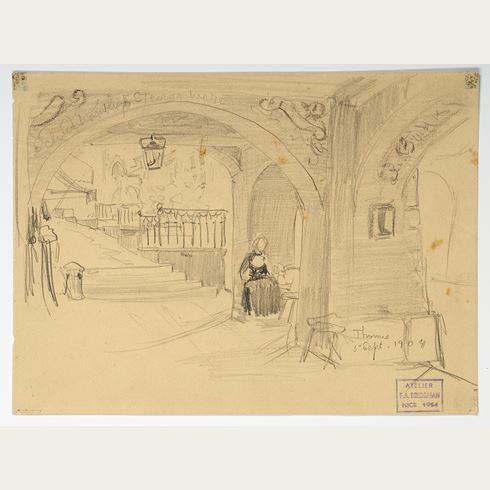Frederick Arthur BRIDGMAN
(Tuskegee 1847 - Rouen 1928)
Study of a Tree
Sold
Pencil and watercolour.
Stamped with the Bridgman studio stamp Atelier F. A. BRIDGMAN / NICE 1954 (not in Lugt) at the lower right.
250 x 306 mm. (9 7/8 x 12 in.)
Stamped with the Bridgman studio stamp Atelier F. A. BRIDGMAN / NICE 1954 (not in Lugt) at the lower right.
250 x 306 mm. (9 7/8 x 12 in.)
One of the foremost American Orientalist painters, Frederick Arthur Bridgman was born in Alabama and began his career as an engraver of banknotes, while at the same time studying at the Brooklyn Art School and the National Academy of Design in New York. In 1866 he won a travel scholarship to study in Paris, where he completed his training with the Orientalist painter Jean-Léon Gérôme at the Ecole des Beaux-Arts, becoming one of the master’s favourite pupils. Bridgman made his Salon debut in 1868, and was to spend the rest of his life and career in France. He spent some time among the colony of artists at Pont-Aven in Brittany and visited the Pyrenees before undertaking the first of several trips to North Africa and Egypt. In 1873 he made a voyage up the Nile, as far as the Second Cataract, that was to provide him with inspiration for a series of major Orientalist paintings for the next few years. From this time onwards he worked almost exclusively as a painter of Orientalist subjects, and returned almost every year in the 1870s and 1880s to Algeria and Egypt. On his trips he acquired numerous examples of local costumes, fabrics and objects, which he kept in his studio and often found their way into his paintings. (Indeed, John Singer Sargent claimed that Bridgman’s studio, full of exotic objects from his travels, was, along with the Eiffel Tower, one of the true sights of Paris.)
Bridgman became a fashionable and successful artist in Paris, keeping two studios and exhibiting frequently at the annual Salons, where he won a number of medals and prizes, as well as in London and America, with which he retained close ties. In 1877 he joined Sargent and others in establishing the Paris Committee of the Society of American Artists, a progressive group which broke off from the New York-based National Academy of Design. An exhibition of over three hundred of his works at the American Art Gallery in New York in 1881, which included both finished paintings and studies, was much admired by critics, and found the artist at the height of his fame and popularity in his native country. Married to a wealthy woman and of independent means, he did not have to sell his paintings to make a living. He was also a gifted musician and composer. Bridgman’s illustrated book, Winters in Algeria, was published in 1890, and in the same year a major retrospective exhibition of his work, numbering around four hundred works, was held at a gallery in New York and later at the Art Institute of Chicago.





